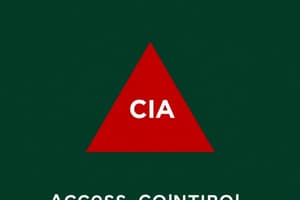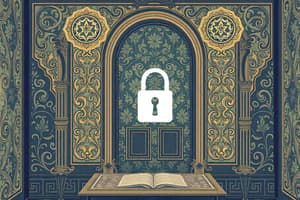Podcast
Questions and Answers
Match the following access control components with their descriptions:
Match the following access control components with their descriptions:
Objects = System resources for which protection is desirable Subjects = Active entities requesting accesses to resources Access mode = Type of access (e.g., read, write, execute) Access Control Models = Categories of access control mechanisms like DAC and MAC
Match the following access control models with their descriptions:
Match the following access control models with their descriptions:
Discretionary Access Control (DAC) = Resource owner specifies who can access specific resources Mandatory Access Control (MAC) = Access control based on security labels and clearances Role Based Access Control (RBAC) = Access control based on roles and permissions assigned to users Access Control Lists (ACLs) = Common implementation of DAC using lists of permissions for resources
Match the following terms with their definitions:
Match the following terms with their definitions:
Owner based access control = Users can protect what they own and define access for others Successful authentication = Granting privileges after confirming user's identity Relationship among Access Control and Other Security Functions = Interconnections between access control and other security measures Access control mechanism = Granting privileges upon validating user's identity
Match the access control model with its description:
Match the access control model with its description:
Match the security classification level with its description:
Match the security classification level with its description:
Match the examples with the type of access control they represent:
Match the examples with the type of access control they represent:
Match the level of access with its description:
Match the level of access with its description:
Match the user with their access rights on File 1:
Match the user with their access rights on File 1:
Match the specific examples with their corresponding access control implementation:
Match the specific examples with their corresponding access control implementation:
What is the primary purpose of an access control mechanism?
What is the primary purpose of an access control mechanism?
In the DAC model, who specifies which subjects can access specific resources?
In the DAC model, who specifies which subjects can access specific resources?
What is the common implementation of DAC that allows owners to control access to their resources?
What is the common implementation of DAC that allows owners to control access to their resources?
Which access control model focuses on defining access based on roles rather than individual users?
Which access control model focuses on defining access based on roles rather than individual users?
What is the highest security classification level in the MAC model?
What is the highest security classification level in the MAC model?
What does Owner-based access control in DAC allow users to do?
What does Owner-based access control in DAC allow users to do?
Who can change the object level in the Mandatory Access Control (MAC) model?
Who can change the object level in the Mandatory Access Control (MAC) model?
Which component of access control specifies the type of actions a user can perform on a resource?
Which component of access control specifies the type of actions a user can perform on a resource?
In Role-Based Access Control (RBAC), what are access decisions based on?
In Role-Based Access Control (RBAC), what are access decisions based on?
What is an example of an access control implementation in operating systems mentioned in the text?
What is an example of an access control implementation in operating systems mentioned in the text?
Which component of the system controls the types of content users can view in web browsers?
Which component of the system controls the types of content users can view in web browsers?
Who can access some personal information on social networks like Facebook and MySpace?
Who can access some personal information on social networks like Facebook and MySpace?
Flashcards are hidden until you start studying




